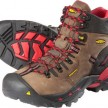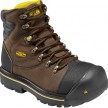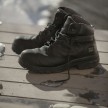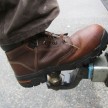Avenger, CAT, Keen, Reebok, Timberland and Thorogood six-inch boots from Zappos at Work
Zappos at Work: Avenger, CAT, Keen, Reebok, Timberland and Thorogood six-inch boots
This is a brief review of six 6-inch work boots from Avenger, CAT, Keen, Reebok, Timberland, and Thorogood, selected by the experts at Zappos at Work specifically for me and my feet. I requested these boots through the Zappos at Work program, a program that’s been up and running at Zappos for a couple of years now. You should know about the program; here’s why.
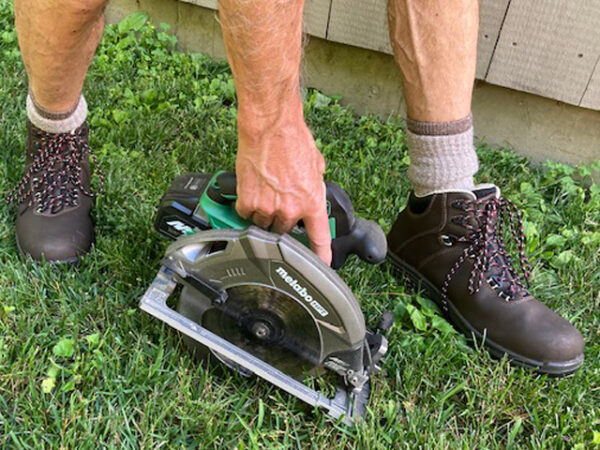
The grizzly in the room
Like Rob, I have a background in a field (law enforcement) where liability is the grizzly in the room with you every day. Most days you’re drinking espresso and playing bocce with the grizzly, and even when you make the espresso a little weak or you mistakenly throw the ball a little bit off, everything’s fine between you two. But every now and then, without warning, the grizzly gets angry – then things get bad. Really bad, really fast.
That’s also how it is with OSHA rules and liability in the trades. Now I’m no lawyer and not even an amateur expert on this subject. I know that how the rules apply to you is pretty complicated. But to the extent that they do, they really do. Every so often we read about a multi-million dollar judgment against a contractor whose employee was injured or killed in an accident where OSHA rules weren’t followed. And often these aren’t even multi-billion dollar international firms — they’re often a small local shop. You don’t want to be that guy – neither the employer nor the unfortunate employee.
When it comes to mandated clothing, you or the crew leader can easily tell at a glance if someone is wearing pants rather than shorts, a hi-viz shirt, eye-pro, ear-pro, a hard hat, and so on. What’s very difficult to assess is whether a worker is wearing shoes or boots with mandated safety features, such as a hard toe, oil resistance, electrical isolation, etc. You can mandate that they do, but enforcing the mandate is hard. Since quality footwear can be expensive, many employees have a tendency to cheap out.
Zappos at Work: Discounted footwear and (possibly) some liability insulation
That’s where programs like Zappos at Work come in. With Zappos at Work an employer sets up a unique account that employees can buy footwear from. The employer can specify the features that the shoes/boots must have, or can even specify specific models that are acceptable. The employer can pay for the purchase, or the employee can pay, or employees can have a certain allowance per time period to spend. There are discounts given, depending on the size of the account and other factors. No matter how the employer set up their Zappos at Work account, they can easily track what their employees buy. Employees are incented to buy proper footwear for the job due to the discount, their allowance, or their employer picking up the tab. Employees get better (and usually more comfortable) footwear than they otherwise would, and employers have an extra layer of liability protection (not to mention employee well-being) regarding a difficult-to-enforce mandate. There’s no program fee and an employer’s outlay for its employees’ footwear is a small outlay compared to the benefits.
It gets better. Each Zappos at Work account receives a personalized email address in order for employees to get guidance from a knowledgeable expert, and all the normal Zappos legendary customer service features apply. There’s no minimum company size to be in the program, and it’s not just shoes that are available – for example, FR clothing and ANSI-rated rain gear are currently big items for the program.
Choosing shoes
If you want to get the most out of buying shoes – including through Zappos at Work – then you really need to know your size. Firstly, you may not be the size that you “think” you are, and second, your foot size changes over your lifetime (in my case, I gained a full size and half in my mid-forties). The best advice here is to go to a store where you can measure each foot (they may be different sizes) with a Brannock device – that’s the steel measuring device that you’ve seen in shoe stores. Make sure you know each foot’s size and width.
Obviously, make sure you know the safety features that you need in footwear, including the OSHA or ANSI specs that they must meet. After all, someone who analyzes industrial accidents for a living has spec’ed the shoes you need for a good reason.
Understand any special needs that you may have. For example, some shoes flex in the arch, while others flex at the ball of the foot. If you have weak arches, a shoe that flexes at the ball of the foot will be more comfortable all day long. Evaluate how stiff of a shank you need; if you’re setting rebar in slabs and walking over the stuff all day, then you want a stiff shank. Do you care how heavy or big your shoes are? If you’re working inside and have to get up and down to your knees or back all day long, then lightweight shoes or boots that aren’t over-large are the ticket. And so on (if you’re a Type 2 or 3 tradesperson, you may want more than one work boot).
The boots
To test out the Zappos at Work program, I requested a selection of boots that would fit my weird (quite narrow, low volume) feet, with the left foot larger than the right. I wanted 6-inch boots so that the higher lacing could cinch the boot around my narrow feet. That’s all the information I gave, and very shortly thereafter (legendary Zappos service!) I had six models to try. Here’s what the person at Zappos said about selecting boots for me: “They were chosen based on customer feedback from after-purchase metrics, as well as our buying team’s insights (comprised of safety footwear experts). The selection sent over included brands and styles customers with a narrow foot prefer, out of the over 60 safety footwear brands we carry. Every person’s foot is different; however for narrower customers those styles are often preferred.”
Each of the boots shipped to me were a nominal “D” width because narrow feet like mine are unusual and narrower width boots are rare. But sure enough: every one of the boots below that Zappos selected did fit me and my weird feet, some better than others of course.
Avenger Breaker Composite Toe
I hadn’t heard of Avenger boots before, but I should have. Their motto is “we only do work”, and they have been very well-reviewed. The Avenger Breaker Composite Toe 6-inch boot (model A7284) features:
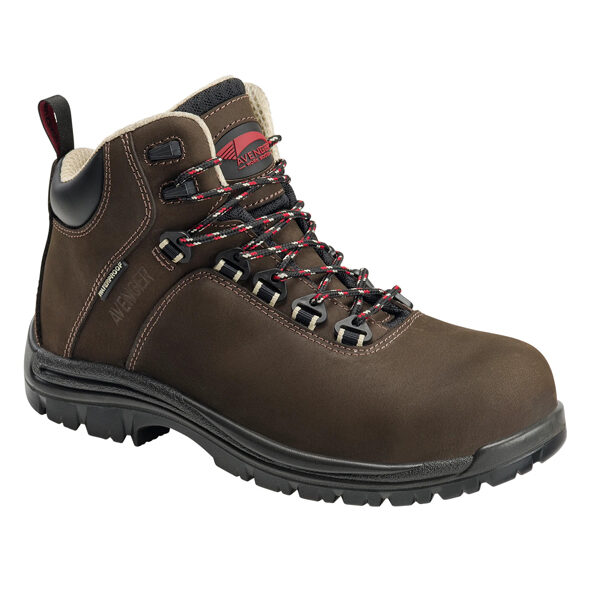
- Full grain leather upper with a traditional lace-up system with metal hardware and fabric laces.
- Composite safety toe that meets or exceeds ASTM 2413-18 I/75 C/75, EH (electrical hazards) standards.
- Waterproof membrane keeps out the wet elements for a drier, more comfortable foot environment.
- Breathable textile lining for a comfortable fit.
- Removable Rebound Foam™ insole with added cushioning for extra support and comfort.
- Lenzi® puncture-resistant plate protects the foot from nails and other sharp objects.
- Direct-attach dual-density PU outsole is oil and slip-resistant with a .35 Mark II slip rating
The Breaker was very comfortable, and fit me well with no heel slip. It’s a relatively light boot, which I like for indoor work. It flexes at the rear of the ball of the foot. Make sure you add Avenger to your list of brands to consider – I was very pleasantly surprised with this boot. $120.
Caterpillar Resorption CT
The Caterpillar Resorption CT (Style 9097X) is more of a traditional boot, with a stiff sole and heavier weight.
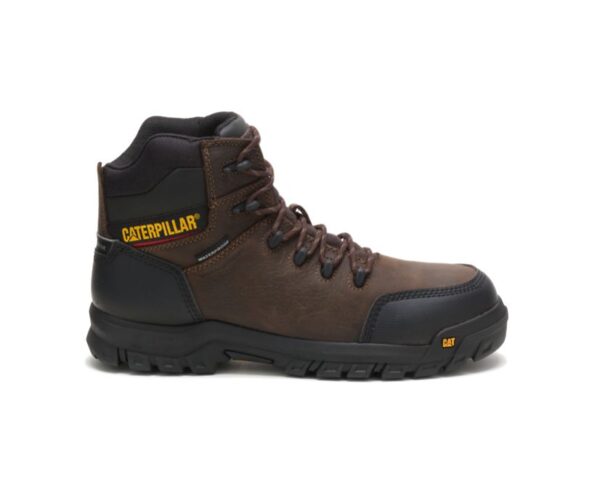
- Non-metallic work boot has with composite safety toe that meets ASTM F2413-11 I/75 C/75 safety standards.
- ASTM F2413-05 1/75 EH Electrical Hazard Protection rated to protect against open circuits up to 600 volts in dry conditions.
- Waterproof full-grain leather upper.
- Traditional lace-up system with fabric laces and sturdy hardware.
- Cement construction provides added durability and flexibility.
- Soft textile lining provides added breathability and comfort.
- Cushioned textile footbed provides superior underfoot support and long-lasting comfort.
- Molded EVA midsole provides added support and shock absorption.
- Durable T1260 outsole is oil and slip-resistant and provides excellent traction. Passes MARK II Testing.
While the fit for very narrow feet like mine wasn’t quite perfect, this is the kind of boot I’d want for rough ground surfaces such as setting rebar, especially if that ground is full of sharp spikey things. The sole flexes near the arch, but it’s also stiff enough that I doubt someone with bad arches would notice. $102.
Timberland PRO Valor Duty CT
The Timberland PRO Valor Duty CT (style 1161A001) is another traditional-feeling boot, but it’s not too heavy. Its zipper side opening makes for easy on/off once you get the laces dialed in.
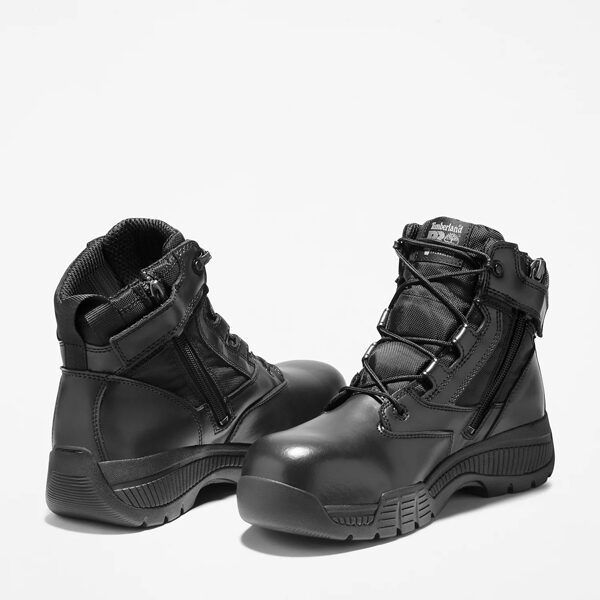
- Waterproof smooth leather and 1200D ballistic nylon upper.
- Traditional lace-up and side zipper design for a secure fit.
- 3M® Scotchgard™ protector provides excellent stain resistance.
- Waterproof membrane.
- Mesh lining with Agion® treatment promotes an odor-free in-shoe environment.
- Padded top collar.
- Cement construction provides flexibility and reduced break-in time.
- Polycarbonate hardware provides lightweight non-metallic durability and is metal-detector friendly.
- Lightly cushioned textile footbed for underfoot comfort.
- Lightweight molded EVA midsole for all-day comfort.
- Nylon shank for added structural support.
- Vibram® rubber outsole has superb traction with exceptional slip resistance, oil resistance, heat resistance and abrasion resistance.
- Durable, non-marking rubber outsole is slip, oil, and abrasion-resistant that is tested to ASTM F2913-2019 Non-Slip Testing Standards.
- Non-metallic, non-magnetic composite safety toe resists corrosion and meets ASTM F2412-11 and ASTM F2413-11 electrical hazard standards.
I believe Timberland sells this model into the public safety sphere, too, for professions there that require its safety feature (firefighters, for example). It certainly has the feel of the better duty boots I used to wear as a cop, and was one of the less narrow boots sent. While the shoe is sort of mid-weight, its sole is very stiff. It bends near the back of the ball of the foot, but much less than some other boots. $136.
KEEN Vista Energy Mid
The KEEN Vista Energy Mid (style 1024592) is a lightweight, very supportive boot. Of all the boots sent, these hugged my narrow feet tied-for-best. Clearly a modern design, the Vista Mid takes advantage of today’s materials and methods to make a very comfortable boot that’s well-suited for interior work (because it’s easy to get up and down with them on) as well as exterior jobsites.

- Constructed with a lace-up closure, composite safety toe, moisture-wicking and a slip-resistant rubber sole.
- Mid-profile work shoes with left and right asymmetrical carbon-fiber safety toes that meet ASTM F2412-17 and F2413-17 F I/75 C/75 EH (electrical hazard) safety standards.
- KEEN.Regen midsole is lightweight and compression-resistant for superior stability and shock absorption. This midsole provides 50% more energy return than standard EVA foam.
- Removable metatomical PU footbed provides long-lasting underfoot support and comfort.
- Non-marking rubber outsole is slip and oil resistant that meets ASTM F1677-96 MARK II and ASTM F2913-17 SATRA Non-Slip Testing Standards.
- Sole features tread design that disperses liquids quickly for reliable traction.
I reviewed the KEEN Dover a while ago, and since it’s a heavier boot I’ll continue to use it for exterior jobs, while the Vista Energy will be a go-to interior job boot. $130
Reebok Rapid Response
This version of Reebok’s Rapid Response boot, the 6-inch, model RB8650, is a re-purposed tactical boot. Reebok describes it thus: The Rapid Response RB is a field-proven tactical boot with advanced comfort technology and durability for modern first responders, law enforcement officers, and military professionals. If you notice a pattern here — duty boots being sold into the construction market — there’s a reason. Both applications require a durable boot with safety features at a reasonable price.

- Cattle hide leather and ballistic nylon upper.
- Mid-profile work boot with composite toe and electrical hazard protection.
- Traditional lace-up design for a secure fit.
- Side zipper with hook-and-loop strap for easy on and off.
- Padded tongue and collar.
- Nylon mesh lining provides breathability.
- Removable FootForce® PU cushion footbed with shock eliminator heel cushion.
- Cushioned EVA midsole.
- Extra wide toe for a roomier fit.
- Dual-density Mountain Trail rubber outsole is oil, slip, heat, chemical, and abrasion resistant.
- Composite toe meets ASTM F2413, EH standards.
This boot fit my very narrow heels less well than some others, but I can still see where people with just “narrow” heels might find it a good fit. Still, quite comfortable. It’s a mid-weight boot with a fairly flexible sole that flexes just fore of the arch. $135.
Thorogood Crosstek
The Thorogood Crosstek (model 804-6494) is a mid-weight boot with a stiff and heavy sole. That said, it does flex easily at the front of the arch.
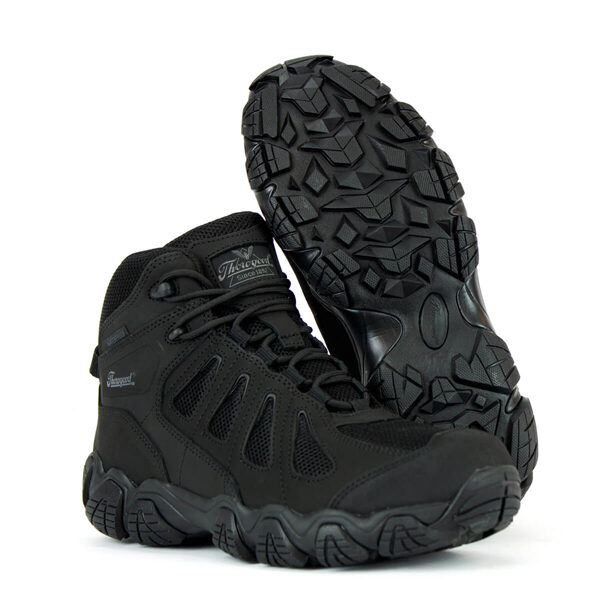
- Hiker work shoe with a composite safety toe cap meets or exceeds ANSI/ASTM F2413-11 M I/75 C/75 EH (electrical hazard) safety standards.
- Hydrostatic Water Test Qap 10.1m.
- Leather and mesh upper.
- Low-profile work shoe.
- Traditional lace-up work boot with metal eyelets and hooks.
- Back heel pull loop.
- Waterproof membrane.
- Cement construction.
- Soft textile lining for excellent breathability.
- Removable SHOCK ZONE PU footbed offers.
- Rubber midsole.
- Crosstrex 360 outsole features multi-directional lugs to provide all-around excellent stability and traction on a variety of surfaces.
- Slip-resistant meets ASTM F 1677-05 Standard.
If the Crosstex looks a bit like a hiking shoe, there’s a reason: Thorogood designed and markets this boot as a crossover. In their words: If you’re looking for a quality hiker with a safety toe, look no further. BBP waterproof, yet breathable, the leather and mesh upper on these mid hiker boots keeps your feet protected from the outdoor elements while a composite toe offers even further security from mishaps or accidents.
I found the Crosstex to fit just ever-so-loose on my very narrow feet, meaning that it’ll fit almost all feet well. $130.
Why not hiking boots?
Some tradies have foregone work boots altogether in favor of hiking boots. Some have gone even further and wear athletic shoes (sneakers) in the job. Their reasoning is that hiking and athletic footwear is more comfortable and requires no break-in (which isn’t really true with many hiking boots). While I understand the urge to go with comfort, I can’t really endorse the practice of not using job-specific footwear.
Hiking shoes obviously don’t have safety features, and their soles are much more easily punctured. Also, they typically aren’t as durable. Plus, hiking boots strive for lightweight at the expense of durability because, well, you’re hiking in them: mile after mile after mile after mile. (Two extra ounces on each foot would mean an extra ton lifted during a 10-mile hike!). Of course, sneakers are even worse in these regards, plus they don’t offer much in the way of lateral stability.
But as much as I love tradition and a good old-fashioned heritage leather work boot, I also choose my tools for their function over their emotional value. In any case, modern work boots, like all of these reviewed above, incorporate athletic shoe and hiking boot materials, construction and methods – there’s really no reason to have to give up the safety features of proper work boots for comfort if you choose your boot carefully. With a program like Zappos at Work you have access to almost any work boot made, so you can find the one that’s right for you.
More than one?
As I mentioned above, many trades-persons will want to have more than one pair of boots available. Possibly for different environments, or possibly so they can be rotated. For example, a friend who was a state forester found that she needed three pairs of boots, because it took two days for a pair to dry out from the wet forest that she was in so often. Again, a program like Zappos at Work can be a big help here, both in finding the right boots, and with the discount or allowance, making multiple pairs affordable.
Conclusion
I’d certainly say that Zappos understood my needs and sent me boots that were appropriate for my feet. Obviously some fit better than others, but that’s normal for anyone. Just having access to expert advice on footwear selection in the very technical area of safety specs, as well as fit is a huge plus. And then there’s the extremely wide selection of brands that Zappos carries; since everyone has different feet, you can try out different boots to find just the right one for you.
All in all I very much recommend the Zappos at Work program, as well as any of the above boots, especially for those of you with odd feet like mine.




